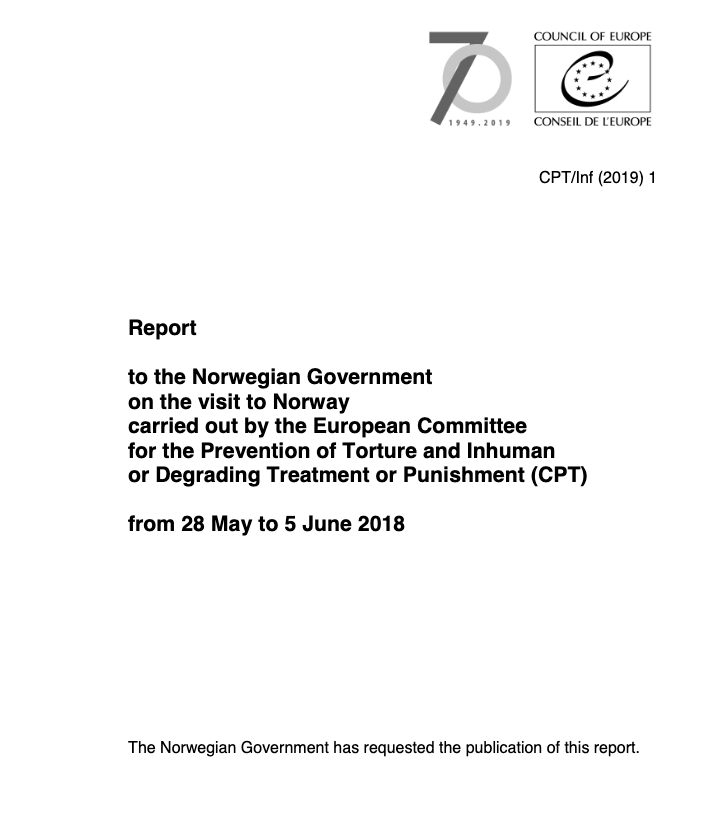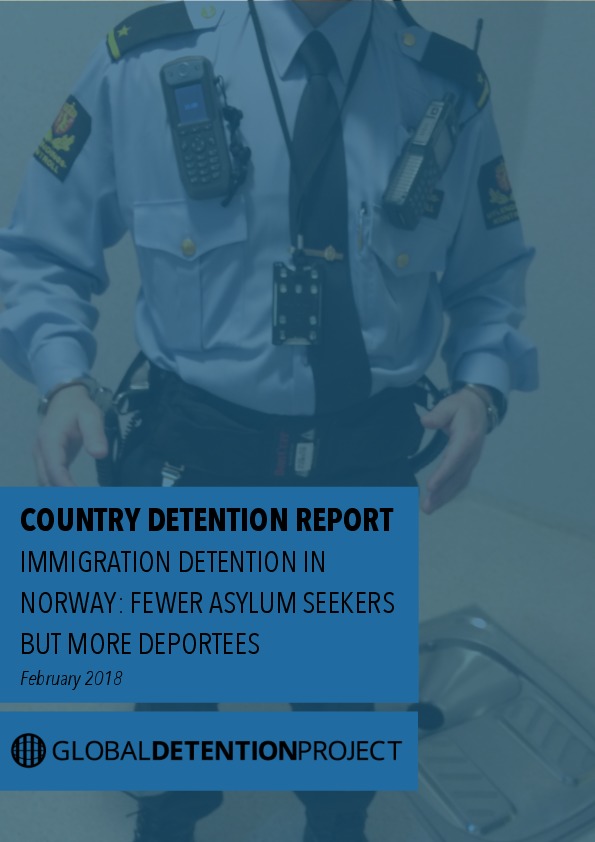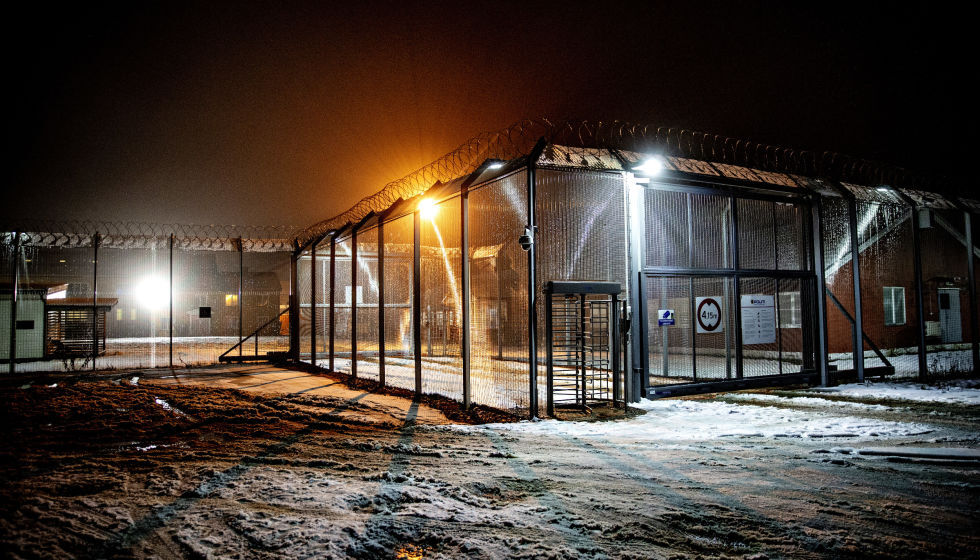Norway’s immigration detention Supervisory Board has criticised practices at the country’s Trandum Immigration Detention Centre. In its Annual Report, the board says that although there have been important changes—including shifting medical care from the private to the public sector—numerous abusive immigration detention practices persist, including “prison-like” operations at Trandum, obliging detainees to meet officials from […]
Reforming Norway’s Trandum Detention Centre
Important reforms are due to be implemented at Norway’s Trandum Detention Centre, raising hopes for improved treatment of people in immigration procedures in the country, according to the 2022 Annual Report of Trandum’s independent oversight board. Among the proposed reforms are several harm-reducing proposals identified by the Global Detention Project in our 2018 report commissioned […]

Norway: Covid-19 and Detention
The supervisory board of Norway’s Trandum Detention Centre, in its annual report about operations at the facility, expressed concern about the implementation of certain COVID-19 measures. Of particular concern are isolation measures imposed on all newly arriving detainees, who are required to quarantine for 10 days upon arrival. During this period, they are locked in […]

Norway: Covid-19 and Detention
The Norwegian Red Cross has reported that since March, it has been unable to access Norway’s sole long-term detention facility, the Trandum Detention Centre. Although the organisation has remained in close contact with the facility’s staff during the pandemic, it has been unable to physically enter the facility and its volunteers have only been able […]

Norway: Covid-19 and Detention
According to the Norwegian Parliamentary Ombudsperson (Sivilombudsmannen), responding to the Global Detention Project’s Covid-19 survey, Norwegian authorities did not impose a moratorium on new immigration detention orders due to the Covid-19 pandemic. However, the National Police Immigration Service (NPIS) limited the number of immigration detention orders due to the reduced capacity at the police immigration […]

Norway: Covid-19 and Detention
The Trandum National Police Immigration Detention Centre, Norway’s only immigration detention facility which has a capacity of 220, had a population of 50 detainees as of 1 April, according to a communication from the Norwegian Red Cross (NRC) to the Global Detention Project (GDP). A series of measures have been implemented to avoid the spread […]

Norway: Covid-19 and Detention
A number of individuals have been released from immigration detention as a result of measures implemented in response to the pandemic. As of early April, the Police Immigration Department had released 10 individuals as deportations became impossible to undertake. Those released are required to remain in a stated location, either a private address or asylum […]

Trandum Police Immigration Detention Centre (from report of the European Committee for the Prevention of Torture 2018 visit to Norway)
Trandum Police Immigration Detention Centre (Read full CPT report) 38. The delegation carried out a follow-up visit33 to Trandum Police Immigration DetentionCentre (hereinafter: “Trandum Detention Centre”), which remains the only immigration detentioncentre in Norway.34 The current policy in Norway is to accommodate asylum-seekers only in openreception centres; thus, Trandum Detention Centre functions primarily as a […]

Last updated: February 2018
DETENTION STATISTICS
DETAINEE DATA
DETENTION CAPACITY
ALTERNATIVES TO DETENTION
ADDITIONAL ENFORCEMENT DATA
PRISON DATA
POPULATION DATA
SOCIO-ECONOMIC DATA & POLLS
LEGAL & REGULATORY FRAMEWORK
Does the Country Have Specific Laws that Provide for Migration-Related Detention?
Detention-Related Legislation
Bilateral/Multilateral Readmission Agreements
GROUNDS FOR DETENTION
Immigration-Status-Related Grounds
Criminal Penalties for Immigration-Related Violations
Grounds for Criminal Immigration-Related Incarceration / Maximum Length of Incarceration
LENGTH OF DETENTION
DETENTION INSTITUTIONS
PROCEDURAL STANDARDS & SAFEGUARDS
Types of Non-Custodial Measures (ATDs) Provided in Law
COSTS & OUTSOURCING
COVID-19 DATA
TRANSPARENCY
MONITORING
Types of Authorised Detention Monitoring Institutions
NATIONAL HUMAN RIGHTS MONITORING BODIES
NATIONAL PREVENTIVE MECHANISMS (OPTIONAL PROTOCOL TO UN CONVENTION AGAINST TORTURE)
NON-GOVERNMENTAL ORGANISATIONS (NGOS)
GOVERNMENTAL MONITORING BODIES
Internal inspection reports on migration-related detention
INTERNATIONAL TREATIES & TREATY BODIES
International Treaties Ratified
Ratio of relevant international treaties ratified
Individual Complaints Procedures
Relevant Recommendations or Observations Issued by Treaty Bodies
§15: The State party should consider reducing the use and length of detention for asylum seekers who enter the State party undocumented.
§ 17: The State party should ensure that persons are held at Trandum only according to the law and only for the duration prescribed by law. The State party should ensure that all detention conditions are in total conformity with international standards, including the United Nations Standard Minimum Rules for the Treatment of Prisoners, in particular with regard to the sanitary conditions and overcrowding.
2012
§13: The Committee, recalling its general recommendations Nos. 30 and 31 (2005) on the prevention of racial discrimination in the administration and functioning of the criminal justice system, recommends that the State party bring the conditions in reception and special return centres, and in reception centres for children, in line with relevant international human rights standards.
2011
> UN Special Procedures
> UN Universal Periodic Review
REGIONAL HUMAN RIGHTS MECHANISMS
Regional Legal Instruments
Relevant Recommendations or Observations of Regional Human Rights Mechanisms
§33: the Norwegian authorities to take urgent steps to:
- ensure that all newly-arrived foreign nationals at the Trandum Holding Centre are promptly examined by a doctor or a fully-qualified nurse reporting to a doctor;
- arrange for the daily presence in the Centre of a person with a recognised nursing qualification;
- ensure appropriate psychological/psychiatric assistance to foreign nationals;
§34: existing procedures to be reviewed at the Trandum Aliens Holding Center in order to ensure that, whenever injuries are recorded by a doctor which are consistent with allegations of illtreatment made by a foreign national (or which, even in the absence of allegations, are indicative of ill-treatment), the record is systematically brought to the attention of the relevant prosecutor, regardless of the wishes of the person concerned;
§35: steps to be taken at the Trandum Holding Centre to ensure that confidentiality of medical data is respected in practice;
§37: steps to be taken to ensure that foreign nationals placed in a security cell and/or subjected to “body cuffs” are always seen by health-care staff.
2011
HEALTH CARE PROVISION
HEALTH IMPACTS
COVID-19
Country Updates
Government Agencies
Ministry of Justice and Police (Justis- og Politidepartementet), http://www.regjeringen.no/en/dep/jd.html?id=463
Norwegian Directorate for Immigration (Utlendingsdirektoratet), http://www.udi.no/Norwegian-Directorate-of-Immigration/
Norwegian Immigration Appeals Board (Utlendingsnemnda), http://www.une.no/
International Organisations
International Organisation for Migration Oslo, https://norway.iom.int/
UNHCR Norway Country Information, https://www.unhcr.org/where-we-work/countries/norway
NGO & Research Institutions
Norwegian Organization for Asylum Seekers, http://www.noas.org/
Norwegian Refugee Council, https://www.nrc.no/
Nasjonalt kunnskapssenter om vold og traumatisk stress, NKVTS, http://www.nkvts.no/Pages/Index.aspx
Norsk senter for menneskerettigheter (Norwegian Centre for Human Rights), http://www.jus.uio.no/smr/english/
Flyktninghjelpen (Norwegian Refugee Council), www.flyktninghjelpen.no
Institutt for Arbeidsliv- og Velferdsforsking (Institute for Labour and Social Research), http://www.fafo.no/index.php/en/
Redd Barna (Save the Children Norway), http://www.reddbarna.no/default.asp?V_ITEM_ID=11539
Amnesty International Norge (Amnesty International Norway), www.amnesty.no
Institutt for samfunnsforsking, www.samfunnsforskning.no
Røde Kors, www.redcross.no
Statistisk sentralbyrå (Statistics Norway), www.ssb.no/innvstat




